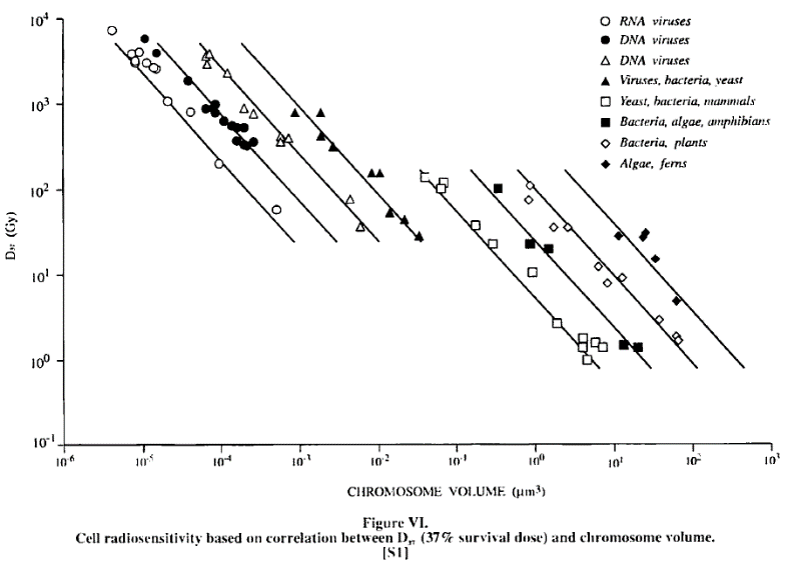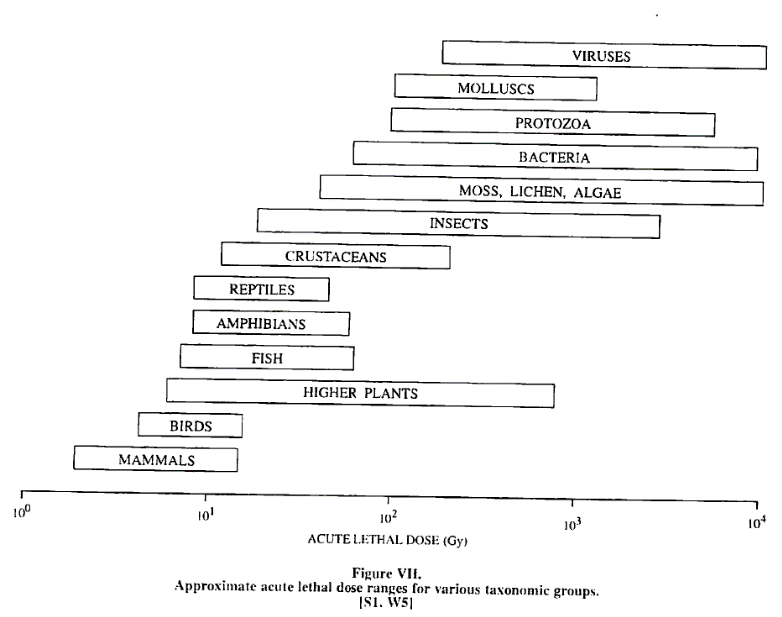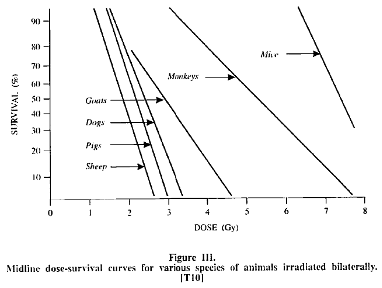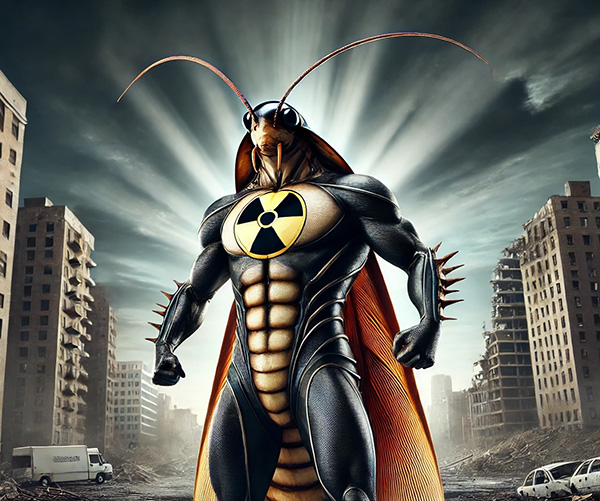Will cockroaches really inherit the Earth?
Hi, Dr. Z! So the other day I was thinking about the cliché that in a nuclear war the only animals to survive will be cockroaches, and then I remembered there’s some microbe that can survive inside of nuclear reactors. And it made me start to wonder how come some types of life can survive more radiation than others. Any thoughts?
Interesting question, and thanks for asking! And you’re right – there is a huge difference in how different organisms respond to radiation – some are remarkably resistant while others can’t handle much at all. Luckily, the United Nations Scientific Committee on the Effects of Atomic Radiation (UNSCEAR) took a look at this a few decades ago in their 1996 report to the General Assembly (the graphics here are from that report).
One of the factors UNSCEAR discussed was the size of an organism’s genome, which makes sense. All else being equal, a larger genome makes a larger target, increasing the chance that a given radiation field will cause damage. This is seen in microbes – bacteria and viruses with a larger volume of genetic material succumb to lower doses than will those with sparser genomes. Similarly, complex organisms have more genes, giving them more targets that can be hit, putting the organism at risk.


And this is what we seem to be seeing in the first two figures – more complex organisms and microbes with larger genomes are less tolerant of radiation than the physical size of an organism seems to make a difference as well. At very small scales, individual bacteria and viruses are so tiny that even a very high dose-rate radiation field won’t see many gamma or x-rays pass through the volume of the cell – a colleague of mine calculated that 1000 rads of radiation from Co-60 will only experience a handful of gammas passing through the cell, and most of these won’t deposit any energy to cause cell damage because the cell is only a few microns thick. Similarly, insects present a smaller target to the incident radiation than do mammals (in addition to having a smaller genome), and more radiation will be stopped by a pig’s body than a mouse’s.

So size is part of it – the size of an organism and the size of the organism’s genome – and this seems to explain some of the variability we see. Is there anything else? Well…yes. Just as long-lived cells are more sensitive to radiation’s effects than are shorter-lived cells, so, too, are longer-lived organisms…sort of – I’ll get to that next. The main thing happening here is that the longer an organism lives, the greater the chance that a gene will be damaged that will lead to cancer or that will cause some sort of disease that will turn out to be deadly. Not only that, but damage that happens early in an organism’s life will have more chances to spread further, birthing more damaged progeny cells; for diseases such as cancer that require multiple “hits” to initiate, a longer lifespan gives a cell with one hit a greater opportunity to experience the additional damage that can spark a cancer. And that gets us to yet another important factor.
See, our bodies don’t just accumulate radiation damage – they have the ability to repair the damage as well, and organisms that have more (and more robust) DNA repair mechanisms tend to survive higher levels of radiation exposure than those with skimpier biochemical protection. In particular, there’s a gene responsible for producing a protein that’s charmingly named p53 – organisms with more copies of the p53 gene tend to do a better job of repairing damage to their genomes and they tend to survive stronger radiation fields than do those with less-robust DNA damage repair. And did I mention that the body produces more of the repair proteins when it senses that DNA damage is occurring? This is a process called “adaptive response.”
DNA repair proteins are very cool – some of them appear to be among the very first proteins assembled by some of the very first organisms to exist on our planet. The genes that tell our bodies how to make these proteins are virtually identical across virtually every form of life on Earth. Not only that, but these proteins repair DNA damage from more than just radiation – they also repair damage from high temperatures, desiccation, oxidative damage, and more. What’s interesting about that is that background radiation causes only a small fraction of our everyday DNA damage – leading some to hypothesize that exposure to small levels of radiation might actually be good for our health, if the “extra” DNA repair proteins fix more damage than what’s caused by the radiation. It makes sense that this might happen…right now, though, we just don’t know if it actually does.
There’s a lot more that can be said about…well…all of this; I have an entire book devoted to DNA repair on my shelf as well as dozens of papers about radiation sensitivity. But this is probably enough for now! So let’s do a quick summary since we covered a bit of ground.
Radiation sensitivity depends on a few factors:
- The size of an organism’s genome (larger genomes are more sensitive),
- An organism’s relative degree of complexity (more complex organisms tend to have larger genomes),
- Larger organisms will intercept more radiation and will capture more of the energy the radiation carries,
- Longer-lived organisms have a longer amount of time for DNA damage to propagate to progeny cells or for cells to accumulate the multiple “hits” required to initiate some diseases,
- Organisms that have more robust DNA repair mechanisms tend to be more resistant to the effects of radiation,
- And our DNA repair mechanisms are ancient, ubiquitous, and very cool!
